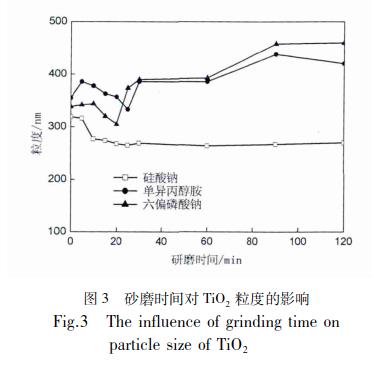IntroductionTitanium dioxide (TiO2) plays a crucial role in various industries, and its dispersion is a critical step in the production process. Efficient dispersion of TiO2 particles is essential to achieve desirable coating properties, such as improved pigment performance and weather resistance. This study focuses on optimizing TiO2 dispersion using a combination of physical and chemical dispersion techniques, specifically the "dispersion-milling" approach. Factors like dispersant type, dispersant dosage, sand milling medium particle size, and milling time were investigated to enhance TiO2 dispersion stability.
Experimental ProcedureVarious dispersants, including sodium silicate, sodium hexametaphosphate, isopropanolamine, carboxylate dispersant, and polyacrylate dispersant, were tested. For each test, 100 mL of distilled water was mixed with a specific dispersant at 0.02 g and stirred until homogeneous. Then, 10 g of TiO2 powder was added, followed by 30 minutes of stirring. The Zeta potential of the resulting TiO2 slurry was measured.
Results and Discussion
1. Influence of Dispersant TypeThe choice of dispersant significantly impacted TiO2 dispersion. Sodium silicate, sodium hexametaphosphate, and isopropanolamine led to larger Zeta potential values, indicating better dispersion. These inorganic dispersants increased the double electric layer on TiO2 particle surfaces, enhancing their Zeta potential. Additionally, they improved the wetting of TiO2 particles by the liquid medium, reducing particle aggregation.
2. Influence of Dispersant DosageThe dispersant dosage was crucial in achieving optimal dispersion. Increasing the dispersant dosage up to 0.25% reduced the slurry's viscosity due to enhanced electrostatic repulsion between particles. However, excessive dispersant concentration in the solution led to higher particle aggregation and increased viscosity. The ideal dispersant dosage was found to be 0.2%.
3. Influence of Sand Milling Medium Particle SizeThe choice of sand milling medium and its particle size greatly affected TiO2 dispersion. Zirconia beads with a particle size of 0.4 μm yielded the best results, with an average particle size of 265 nm achieved after 30 minutes of milling. Other particle sizes of milling medium resulted in less desirable dispersion outcomes, with particle sizes exceeding 300 nm.
4. Influence of Sand Milling TimeThe duration of sand milling also played a significant role in TiO2 dispersion. When using isopropanolamine and sodium hexametaphosphate as dispersants, TiO2 particle size initially decreased with longer milling times but eventually exhibited a "reverse milling" phenomenon. In contrast, sodium silicate as a dispersant did not lead to "reverse milling," as it allowed TiO2 particles to achieve full dispersion without re-aggregation. The optimal milling time with sodium silicate as the dispersant was 25 minutes, resulting in an average particle size of 265 nm.
5. TiO2 Particle Morphology AnalysisTransmission electron microscopy analysis revealed the morphological changes in TiO2 particles before and after dispersion-milling. Prior to dispersion, TiO2 particles were agglomerated. After dispersion-milling, TiO2 particles achieved uniform dispersion, with particle sizes reduced to approximately 260 nm. The particle distribution became narrower, and irregularities were corrected. TiO2 particles exhibited a more spherical shape and were in a monodispersed state.

ConclusionIn conclusion, optimizing the dispersion of TiO2 particles is crucial for enhancing their performance in various applications. Sodium silicate, sodium hexametaphosphate, and isopropanolamine proved to be effective dispersants, with sodium silicate demonstrating the best results. Zirconia beads with a particle size of 0.4 μm and a milling time of 25 minutes were identified as optimal parameters for achieving uniform and stable TiO2 dispersion. These findings have important implications for the production of TiO2 and similar powder particles like SiO2, kaolin, and CaCO3. By improving dispersion techniques, manufacturers can enhance the quality of their products and their performance in various applications.

Submit your demand,
we will contact you ASAP.

Sanxin New Materials Co., Ltd. focus on producing and selling ceramic beads and parts such as grinding media, blasting beads, bearing ball, structure part, ceramic wear-resistant liners, Nanoparticles Nano Powder

